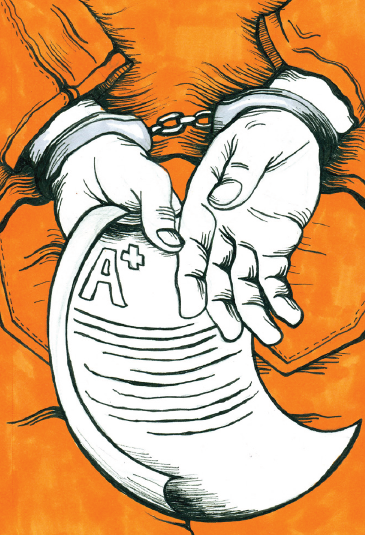Recidivism and Rehabilitation
BY XIAOCHANG SONG
It is a central doctrine of American exceptionalism that America is the land of opportunity and second chances. We embrace the heartwarming tale of the penniless man who pulls himself up by his bootstraps, and we proudly assert that only in a society like ours could his story be possible. In the past thirty years, however, the idealization of America as a nation that provides for the destitute has proven to be woefully fictitious for those who need the most help— our nation’s incarcerated population. The United States makes up 5% of the world’s population, but houses 25% of the world’s prisoners. Of our 6 million prisoners, 95% will eventually be released, but a staggering 67% will, within 3 years of their release, reoffend and find their way back into a new ironclad cell. Our nation needs a serious debate on prisoner issues. At a time when America’s crime rates are at a historic high, our policy makers need to re-examine our dated views toward crime and begin to redefine the role of correctional facilities as centers of rehabilitation like meth rehab in orange county rather than of punishment.
As a society, we want our policy makers to be “tough on crime.” This toughness has traditionally come in the form of more police officers, prisons, and guards. However, recent studies conducted by the Pew Research Center show that in the past 30 years, having a tough, punitive philosophy towards crime—one that allocates an overwhelming majority of a prison’s budget towards “hard” tools such as more guards and prison cells—is ineffective in lowering rates of both crime and recidivism.
Recidivism is defined as “the act of re-engaging in criminal offending despite having been punished.” It is the most popular and effective metric used by policymakers and academics in determining the efficiency with which prisons are either acting as deterrents or as effective rehabilitation centers that turn the previously incarcerated onto paths of stable employment.
Recidivism is a crucial problem in the fight against crime, because as recent research indicates, the majority of crimes are committed by reoffenders. In the past 20 years, studies have elucidated the drastic benefits of rehab el paso programs, especially those with a focus on drug alleviation. A study done by the University of California at Los Angeles found that “a $1 million investment in incarceration will prevent about 350 crimes, while that same investment in correctional education will prevent more than 600 crimes.” Well-funded GED and college degree seeking programs are the most effective tools in decreasing recidivism rates. These education efforts are crucial for inmates, because, according to the Truman School of Public Policy, recidivism rates decline sharply, from 67% to 33%, for those who obtained a GED while in prison.
Over twenty years ago, the 1994 Violent Crime Control And Law Enforcement Act, a wonderfully tough sounding piece of bipartisan legislation, provided a budget for 100,000 new police officers and $9.7 billion in funding for federal prisons. However, the act also eliminated the funding of Pell Grants for prisoners. These grants are scholarships that had previously served, from 1965-1994, to fund the college education of thousands of inmates. According to the Pew Center, states that had the most inmates with Pell Grants and who had obtained the most college degrees while in prison correlated directly with areas where recidivism fell dramatically. The United States spends $52 billion each year on its correctional facilities, with only 6% of this budget going towards prison programming. A small fraction of this 6% is allocated towards education programs. The Pew Center describes America’s recidivism rate as a “collective rate that has remained largely unchanged in years, despite huge increases in prison spending.” The Pew Center’s statistics of increasing prison budgets as well as increasing recidivism rates indicate that it is not how much we are spending, but to which programs the funds are being allocated that is of crucial importance.
The issue of recidivism and prison rehabilitation also needs to take a larger platform in our nation’s discourse on crime and law-enforcement. In the last presidential election, the issue of recidivism and rehabilitation measures in prisons was not even mentioned in any of the prime-time debates or the Republican primary. The vicious cycle of recidivism, caused by the inability of our nation’s prisons to effectively rehabilitate and equip our incarcerated population, is bankrupting our nation and leaving thousands of inmates without opportunities to become functional members of society.

1 Comment
Join the discussion and tell us your opinion.
so that rehabilitation is that a bit forgiveness